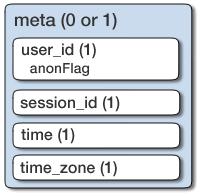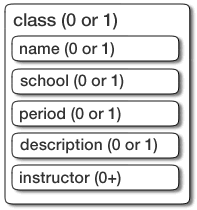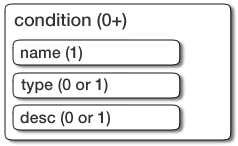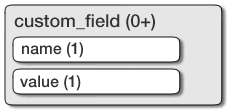The first element contained in the <tutor_related_message_sequence> should be a <context_message>. This single message establishes
the context for the following sequence of elements (<tool_message>, <tutor_message>, or <message>).
For a researcher, a <context_message>
can answer questions such as:
-
Were these data collected in a classroom? If so, what were the details?
-
Is there a hierarchy surrounding this data sequence?
-
Were these data from a particular research condition?
-
With which problem or activity do these log messages correspond?
![[Tip]](images/tip.gif) | Tip |
|---|---|
|
You only need to log a single |
A <context_message> has two required
attributes:
-
name -
context_message_id
The name attribute is used to
indicate where the student is in the process of working on a tutor or
problem. The PSLC DataShop team has established some canonical values
for this attribute that should be used, displayed in Table 1, “Recommended values for the <context_message> name
attribute”.
Table 1. Recommended values for the <context_message> name attribute
| Description | Preferred value | Other possible values |
|---|---|---|
| Starting a problem or activity | START_PROBLEM |
|
| Skipping a problem or activity | SKIP_PROBLEM |
|
| Resuming a problem or activity | RESUME_PROBLEM |
|
| Finishing a problem or activity | DONE_PROBLEM |
|
| Quitting a problem or activity | QUIT_PROBLEM |
|
| Resetting a problem or activity | RESET_PROBLEM |
|
| Reading (REAP) | READING |
The context_message_id attribute
ties a sequence of tutor-related messages together; when referenced in
the other messages, it identifies this message as providing the
relevant context.
![[Important]](images/important.gif) | Important |
|---|---|
|
The value of the |
The <meta> element supplies the same
information as the OLI <log_action>
element (i.e., user ID, session ID, time, and time zone); it is
redundant to supply this information twice. So if logging from
inside the OLI course delivery system, you may omit the <meta> element; otherwise, you must
include a <meta> element in the context
message and all other messages you send.
![[Note]](images/note.gif) | Note |
|---|---|
|
If your tutor appears within an OLI course, don't provide a
|
If you are supplying a meta element, you must supply its four child elements:
The user ID of the current user. A single Boolean
attribute, anonFlag, specifies
whether or not the supplied user ID has been anonymized. Its
default value is false. If set to true, then DataShop will not
re-anonymize the user ID.
A dataset-unique string that identifies the user's session with the tutor.
Local time; must be one of these accepted formats.
The local time zone name, such as one from the "TZ" column in this List of zoneinfo time zones. Three-letter time zone abbreviations such as "EST" and "PST" are still valid, but are deprecated.
Here is our XML so far, including the meta element:
<?xml version="1.0" encoding="UTF-8"?>
<tutor_related_message_sequence version_number="4">
<context_message
context_message_id="0CEF2E07-24DE-BFDA-9BAB-957C3AE236CE"
name="START_PROBLEM">
<meta>
<user_id>student01</user_id>
<session_id></session_id>
<time>2005/02/22 06:43:47.002</time>
<time_zone>US/Eastern</time_zone>
</meta>
</context_message>
</tutor_related_message_sequence>
The <dataset> element and its
descendant elements describe the DataShop dataset to which the data
should belong; the hierarchy of "levels" in which the current
problem exists; and the current problem.
If you are converting these data to the Tutor Message format from another format, include the date and, optionally, the time, that these data were converted.
If you are converting these data to the Tutor Message format from another format, include the name of the tool used to perform the conversion, the tool's version, and the date the tool was created or released.
A <dataset> requires a single
<name> element, the value of which
will appear in the DataShop as the title of the dataset.
![[Note]](images/note.gif) | Note |
|---|---|
|
Dataset |
Nested <level> elements describe
the curriculum hierarchy, a positioning of the problem within an
organization you define. While nested <level> elements are common, only a single
<level> is required.
This element has a single attribute:
-
type: the type of level, usually something like "unit", "section", "chapter", etc. Maximum length of ≤ 100 characters.
A <level> is composed of a <name>, and
either another <level> or a <problem>. This
structure can either repeat—a nested <level> element—or a <problem> element can be included. There
is no limit on the depth of the level hierarchy.
Provide a name for your level. For example, a name of "Understanding Fractions", when combined with a level type of "Section", produces "Section Understanding Fractions".
The <problem> element
contains both a <name> and a <context>.
![[Note]](images/note.gif) | Note |
|---|---|
|
Only one |
The <problem> element has
two attributes: The tutorFlag attribute can be any of the
following values:
-
tutorFlag: can be any of the values specified in Table 2, “Recommended values for the tutorFlag attribute” -
other: a value not listed in Table 2, “Recommended values for the tutorFlag attribute”; stored only iftutorFlagisother.
Table 2. Recommended values for the tutorFlag attribute
| Value of tutorFlag attribute | Description |
|---|---|
tutor | Denotes a tutored problem. |
test | Denotes a test problem. |
pre-test | Denotes a pre-test problem. |
post-test | Denotes a post-test problem. |
other | Used to describe a problem that does not fit
any of the above categories. If tutorFlag is other, then the
other attribute must be
filled in with application-specific data indicating
where the problem falls in the spectrum between
tutor and test. If tutorFlag is one of the
other values in this table, then the other attribute is
ignored. |
![[Note]](images/note.gif) | Note |
|---|---|
|
If |
The name of the problem (e.g., "FractionAddition-1-2plus1-3").
The <context>
element's value can be any string that provides more
information—a text prompt to the student, a scenario,
or other descriptor—but should not be HTML: HTML is
not validated as part of the schema or by DataShop,
and it has the potential to break the DataShop
interface when viewed.
The following code snippet defines a problem with a "unit-section" curriculum hierarchy. The problem "ChemPT1" falls within "Unit A", "Section One".
<?xml version="1.0" encoding="UTF-8"?>
<tutor_related_message_sequence version_number="4">
<context_message context_message_id="0CEF2E07-24DE-BFDA-9BAB-957C3AE236CE"
name="START_PROBLEM">
<dataset>
<name>Stoichiometry Study 1 - Spring 2005</name>
<level type="Unit">
<name>A</name>
<level type="Section">
<name>One</name>
<problem>
<name>ChemPT1</name>
<context>Chemistry Problem One</context>
</problem>
</level>
</level>
</dataset>
</context_message>
</tutor_related_message_sequence>
The <class> element is used to
describe the context of tutor usage in a school.
Of its child elements, only <instructor> can occur more than once.
![[Note]](images/note.gif) | Note |
|---|---|
|
If class name is not filled in, but period is, then period will be used as the class name. If class name and period name are not filled in, but description is, then the description will be used as the class name. |
The name of the class in which the tutor is used (eg, "Intro to Chemistry").
The school in which the tutor is used (eg, "Perrysville Elementary").
A <condition> describes a study
condition, in the case that these data are being collected in the
context of a research study.
Zero or more <condition> elements
are allowed.
If a <condition> is included, it
must have a <name>, which cannot be an
empty element. Optionally, <condition>
can include a <type> and <desc>, or description.
The name of the condition (eg, "Unworked").
![[Important]](images/important.gif) | Important |
|---|---|
|
In DataShop, condition name must be unique within a
dataset, so do not rely on |
A condition classification (eg, "Experimental", "Control").
A <skill> in a context message is a
description of a knowledge component that may be exercised by the
student in the course of solving the problem or activity. It's
primary purpose is to describe the probability of the student
knowing the skill at the beginning of the
problem. This probability is commonly used to track student mastery
of knowledge components ("mastery learning") through a
knowledge-tracing algorithm.
![[Note]](images/note.gif) | Note |
|---|---|
|
A |
For a description of the skill content model, see Section 2.6.2.2, “<skill>” in tutor_message.
Use this element to describe other contextual information not adequately captured by the other context message elements.
Zero or more <custom_field>
elements are permissible.
![[Note]](images/note.gif) | Note |
|---|---|
|
While DataShop does not use or show this information in its
reports, the content of a |






